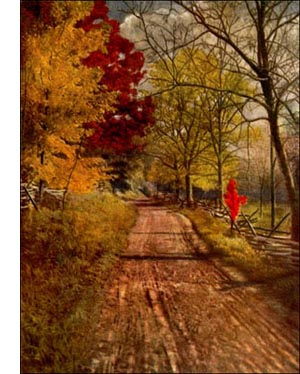Large Leaved Cucumber Tree
 Large-leaved Cucumber Tree (Magnolia macrophylla, Michx.)-A broad, round-headed tree, 30 to 50 feet high, with slender trunk and stout branches. Bark thin, smooth, grey, minutely scaly. Wood light, close textured, pale brown, weak; sap wood thick, yellow. Buds terminal, 1 1/2 to 2 inches long, blunt, covered with white silky hair; axillary small, flat. Leaves 16 to 30 inches long, obovate, rounded or acute at apex, broadened at base into ear-like lobes, or deeply cordate, margin entire; upper surface bright green, lining silvery white; petioles stout, 3 to 4 inches long, veins prominent. Flowers 10 to 12 inches across, bowl shaped, made of 6 white fleshy petals much broader than the 3 sepals. inner petals with purple spot at base. Fruit almost (globular, 2 to 3 inches long, turning red at maturity. Seeds 2/3 inch long. Preferred habitat, deep, fertile valleys, protected from wind. Distribution, foot hills of Alleghany Mountains in North Carolina, south to middle Florida, and west to southern Alabama, to northern Mississippi and Louisiana, and in central Arkansas; range not continuous, trees occur in small, detached groups. Uses: Cultivated as an ornamental tree in Europe and America. Hardy to Boston.
Large-leaved Cucumber Tree (Magnolia macrophylla, Michx.)-A broad, round-headed tree, 30 to 50 feet high, with slender trunk and stout branches. Bark thin, smooth, grey, minutely scaly. Wood light, close textured, pale brown, weak; sap wood thick, yellow. Buds terminal, 1 1/2 to 2 inches long, blunt, covered with white silky hair; axillary small, flat. Leaves 16 to 30 inches long, obovate, rounded or acute at apex, broadened at base into ear-like lobes, or deeply cordate, margin entire; upper surface bright green, lining silvery white; petioles stout, 3 to 4 inches long, veins prominent. Flowers 10 to 12 inches across, bowl shaped, made of 6 white fleshy petals much broader than the 3 sepals. inner petals with purple spot at base. Fruit almost (globular, 2 to 3 inches long, turning red at maturity. Seeds 2/3 inch long. Preferred habitat, deep, fertile valleys, protected from wind. Distribution, foot hills of Alleghany Mountains in North Carolina, south to middle Florida, and west to southern Alabama, to northern Mississippi and Louisiana, and in central Arkansas; range not continuous, trees occur in small, detached groups. Uses: Cultivated as an ornamental tree in Europe and America. Hardy to Boston.This species excels all other magnolias in the size of its leaves and flowers. The leaves are almost a yard long. In fact, no tree of simple leaf approaches it outside of the tropics. It is the remarkable size of its leaves and flowers that commends this tree to planters. Of beauty we cannot credit it with quality to match its size. A flower as big as a man's head is sure to be lacking in delicacy. There is a dash of purple at the base of the inner row of petals. The wind lashes the broad leaves into ribbons early in summer, and every twig or leaf that touches a petal mars it with a brown bruise. So the flowers soon spread wide open and become discoloured. Two fine young specimens stand in front of the Museum of the Arnold Arboretum, Boston. The protection of the building and the border planting are not sufficient to defend these trees from the common fate of all plants which offer an unusual expanse of leaf surface in a region where winds are frequent and strong. Though but a dozen feet high these trees have already bloomed freely. The silvery leaf linings tend to obscure the white flowers in spite of their extraordinary size.
People who desire to plant this magnolia do well to shelter it from wind and cold. At best it is but half hardy in the North. It is a curiosity. Prominent situations are better filled by species of tried hardiness, whose beauty is admitted to be a joy at any season.